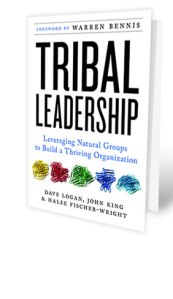 I spent some time last month listening to a free audio book called Tribal Leadership: Leveraging Natural Groups to Build a Thriving Organization. I knew that the book was available as a free download because I follow the Twitter tweets of Tony Hsieh, the CEO of Zappos.com. If Tony, an innovator and business leader, recommended it to his followers, I knew that it would be well worth reading. He actually contributed to the audio book’s forward, and having listened to the book, I can see why the authors chose him.
I spent some time last month listening to a free audio book called Tribal Leadership: Leveraging Natural Groups to Build a Thriving Organization. I knew that the book was available as a free download because I follow the Twitter tweets of Tony Hsieh, the CEO of Zappos.com. If Tony, an innovator and business leader, recommended it to his followers, I knew that it would be well worth reading. He actually contributed to the audio book’s forward, and having listened to the book, I can see why the authors chose him.
The book revolves around the central concept of companies existing as bands of tribes (from as many as 20 people to 150 people per tribe). In effect, an organization is like a state with multiple small towns within it. These are not necessarily your department, but loose associations of thought leaders and colleagues. Tribal groups are formed by the replication of what the authors call “triads.” Triads are strong three-party relationships. This is important factor for organizations with a tribal culture, because the authors know that only a three-legged stool can stand, and that by sharing work among colleagues, there is a mutually-supportive structure, rather than a top-down, one-on-one, senior-to-junior dynamic at work.
If you look for it, you will see these triad relationships everywhere in successful companies. Think about LinkedIn, which relies on you working through your existing contacts to reach another contact in the system (a triad). The book also focuses on the fact that successful tribal company cultures are not about “me”, they are about “we.” While company cultures can focus on the superstars, they do so at their own peril. Real superstars are always forming triads and bringing out the best in their colleagues. They are using what helped the Celts win the championships – Ubuntu – and the knowledge that no one can make it alone.
The book provides case studies of the companies that are getting Tribal Leadership right, like Amgen. Companies, as well as individuals, can be found on a continuum from stage 1 (totally failing) to stage 5 (incredibly successful). About half of all companies in America are in stage 3 where self-accomplishment is the core value celebrated (it’s about my success). Companies at stage 5 are in a league of their own (they don’t see themselves as having competitors, just major problems to solve – cancer, bad customer service). Companies at stage 5 are also incredibly open and share information fluidly among the tribal members (and social networking is increasingly helping them create this openness and transparency).
There’s something extremely attractive about a stage 5 tribal culture, and a lot to admire in Tribal Leaders. While these leaders can exist at companies that have yet to make it to tribal excellence, the book suggests that through practicing the creation of triads, being group-oriented and checking their egos at the door, leaders can help to elevate their companies. Next time you’re in a meeting, count the number of times someone says “me” when they could be saying “we.” Now listen to yourself. And, definitely listen to this important book, for free. 
Recent Comments